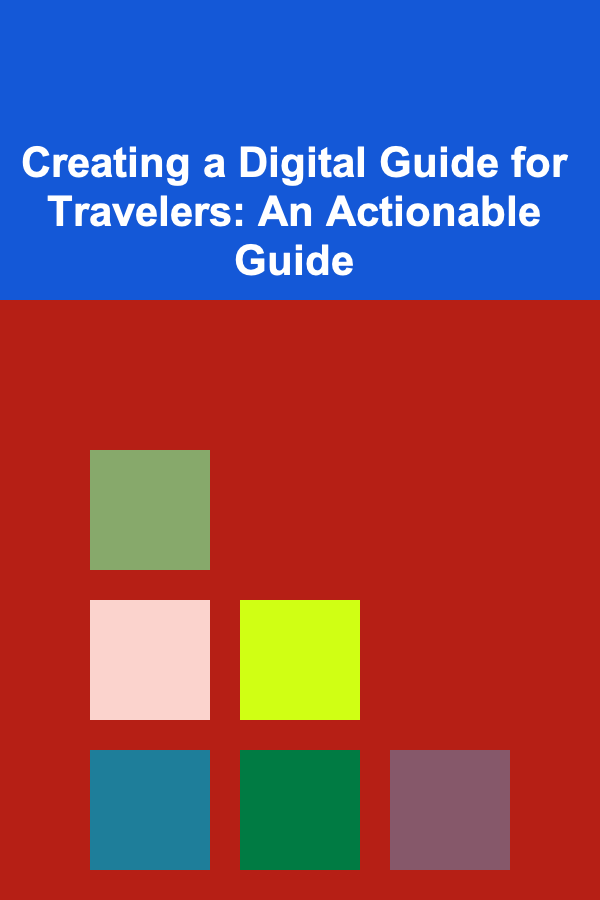
Creating a Digital Guide for Travelers: An Actionable Guide
ebook include PDF & Audio bundle (Micro Guide)
$12.99$8.99
Limited Time Offer! Order within the next:

Traveling has evolved into more than just an activity---it's now an experience that can be shared, researched, and planned digitally. With the rise of smartphones, digital nomads, and the explosion of online travel content, travelers are now seeking out detailed, accessible, and user-friendly digital guides to enhance their journeys. Whether you're a seasoned traveler, a travel blogger, or a business looking to offer value to customers, creating a digital travel guide can be a rewarding and effective way to share your expertise.
In this actionable guide, we'll explore the essential steps to creating a comprehensive, engaging, and practical digital guide for travelers. We'll dive deep into every aspect of the creation process, from research to design, to distribution and monetization.
Understand Your Audience and Purpose
1.1 Defining Your Target Audience
Before embarking on the creation of your digital travel guide, you need to know who you're creating it for. Understanding your audience will guide your content, tone, design, and distribution strategies. Here are a few questions to help define your target audience:
- Who are your ideal travelers? Are they backpackers, luxury travelers, solo explorers, or family vacationers?
- What are their pain points? Do they struggle with language barriers, transportation navigation, finding affordable accommodations, or understanding local customs?
- What experience do they want to have? Are they looking for adventure, relaxation, culture, or all three?
- What platforms do they use most? Do they prefer using mobile apps, downloading PDF guides, or reading web-based content?
Understanding your audience allows you to craft the guide's content and design in a way that speaks directly to their needs and desires.
1.2 Clarifying the Purpose of Your Guide
Next, you need to define the core purpose of your travel guide. The purpose will affect the structure and depth of the content. Here are some potential goals for your digital travel guide:
- Comprehensive destination guide: Focuses on providing in-depth information about a specific city, region, or country, including landmarks, restaurants, accommodations, activities, and cultural insights.
- Niche travel experience: Tailored guides for particular types of travelers---such as foodies, adventure seekers, solo travelers, or eco-tourists.
- Step-by-step travel planning: Offers practical advice on organizing a trip, from booking flights to planning itineraries.
- Local insider guide: Shares recommendations from locals or experienced travelers, offering a more authentic experience than typical tourist spots.
- Packing and travel essentials: Guides travelers on what to pack for different climates, activities, and duration of trips.
By defining both your target audience and the specific purpose of your guide, you create a solid foundation for the content, tone, and overall layout of the guide.
Gather and Organize Content
2.1 Research Your Destination(s)
Accurate and up-to-date information is essential for a travel guide. Extensive research is critical to provide valuable insights. Consider using a combination of resources for gathering your information:
- Online Travel Platforms: Websites like TripAdvisor, Lonely Planet, and Airbnb Experiences often feature helpful reviews and recommendations.
- Government Tourism Websites: Local tourism boards provide accurate details about attractions, transportation, events, and safety information.
- Social Media and Blogs: Platforms like Instagram, YouTube, and travel blogs often showcase local experiences and provide up-to-date information on what's popular or hidden gems.
- Interviews with Locals or Experts: Speak to local business owners, residents, or other travelers to get firsthand insights and tips. Their recommendations can give your guide authenticity and depth.
2.2 Organize the Content
Once you have gathered all the necessary information, it's time to organize it logically and cohesively. A well-structured guide makes it easy for readers to navigate and find the information they need. Here are some common sections you might include:
- Introduction: Briefly introduce the destination, its culture, and what readers can expect from the guide.
- Destinations: Break down the main areas or cities within the destination and provide detailed descriptions of each.
- Things to Do: List and describe popular activities, both typical tourist attractions and off-the-beaten-path experiences.
- Dining and Accommodation: Offer recommendations for food and lodging, including budget, mid-range, and luxury options.
- Transportation: Explain how to get around the destination, including public transportation, taxis, rental cars, and walking routes.
- Travel Tips: Share practical advice, such as the best time to visit, safety tips, and local customs.
- Budgeting and Costs: Provide information on costs related to dining, attractions, transportation, and accommodation, tailored to different budget types.
- Local Insights: Add insider tips from locals or frequent travelers, giving your guide an authentic touch.
2.3 Keep the Information Updated
Ensure that your information is current and accurate. Traveling can involve changes, such as new opening hours for attractions, transportation changes, or emerging trends. Regularly update your guide to reflect any significant shifts in the destination you are covering.
Design and Format the Guide
3.1 Choose the Right Format
Once you have your content, it's time to decide how to format it. Travelers often prefer guides that are easy to download, use on-the-go, and share with others. Popular formats include:
- PDF: Portable and easily downloadable, PDF guides are easy to distribute and can be printed if needed. It's ideal for a detailed, downloadable guide.
- Mobile App: If you have the resources, creating a custom app can be highly beneficial. Apps allow you to deliver a seamless, interactive experience with GPS maps, offline access, and push notifications.
- Web-Based Guide: A mobile-friendly website or blog is an excellent option for travelers who prefer browsing through their smartphone browser. It's easier to update and can feature multimedia like videos, interactive maps, and links to external resources.
- Interactive eBooks: An eBook offers a great balance between a detailed written guide and the portability of a mobile app. It can include clickable links, embedded photos, and even videos.
3.2 Prioritize User Experience (UX)
A travel guide must be easy to navigate. A cluttered or confusing design will make readers abandon the guide before they can gain any value from it. Consider the following design principles:
- Simple navigation: Make sure readers can quickly find the information they're looking for through clear headings, a clickable table of contents (if digital), and search functionality.
- Readable fonts and layouts: Use fonts that are easy to read, and format the text with appropriate headings, subheadings, and spacing to make the guide visually appealing.
- Mobile-friendly design: Many travelers access guides via smartphones, so it's crucial to ensure that the design is mobile-responsive, meaning it adjusts to fit different screen sizes.
- Interactive features: Adding clickable maps, external links, or embedded videos can enhance the user experience and offer practical value.
3.3 Include Visual Elements
Travel guides are visually driven, and images can significantly enhance your content. Use high-quality images of landmarks, food, people, and activities to bring the destination to life. Additionally, incorporate the following visual elements:
- Maps: Incorporate easy-to-read maps to help users navigate their destination.
- Infographics: Use infographics to break down complicated information, such as budgeting tips or itineraries.
- Icons and Buttons: These can be used for clear navigation, links to external resources, and calls-to-action.
Publish and Distribute Your Digital Guide
4.1 Choose the Right Distribution Channels
Once your guide is ready, you'll need to choose where and how to distribute it. Depending on your target audience, here are a few options:
- Website: Host the guide on your website, offering it as a downloadable PDF or link to a web-based guide. Use a landing page to capture user emails if you want to offer the guide in exchange for their contact information.
- Ebook Platforms: Publish your guide on platforms like Amazon Kindle or Apple Books for wider distribution. These platforms allow you to sell the guide or offer it for free in exchange for reviews or email sign-ups.
- Social Media: Promote your guide through platforms like Instagram, Facebook, or Twitter. Use visuals and short snippets to attract attention, then link to your website or landing page for access.
- Email Marketing: Send out the guide via email to subscribers, offering it as a free bonus or part of a broader marketing campaign.
4.2 Leverage SEO and Keywords
Search Engine Optimization (SEO) is essential for increasing the visibility of your travel guide online. Focus on incorporating keywords relevant to your destination and niche throughout the guide and your promotional content. Some techniques include:
- Using keywords in titles, subtitles, and image descriptions.
- Creating blog posts related to your guide's content to increase organic traffic.
- Encouraging backlinks from other websites and bloggers in the travel niche.
Monetize Your Travel Guide
If you're looking to generate income from your travel guide, there are several strategies to monetize it:
5.1 Affiliate Marketing
Incorporate affiliate links within your guide for products or services that travelers might find useful---such as hotels, travel insurance, tours, or gear. When readers purchase through your link, you earn a commission.
5.2 Selling Your Guide
If you're offering a paid guide, set a reasonable price based on the value you're providing. A well-researched, high-quality guide can easily command a fee, especially for niche travel experiences or hard-to-find destinations.
5.3 Sponsored Content
Partner with tourism boards, local businesses, or travel brands to include sponsored content within your guide. This could be in the form of featured listings or advertisements promoting specific businesses that align with your audience's needs.
Creating a digital guide for travelers is not just about providing useful information; it's about enhancing the overall travel experience. By understanding your audience, structuring your content thoughtfully, and using the right design, you can create a resource that travelers will not only use but also share and recommend. With the right distribution strategy, your digital guide can become an essential tool for travelers and a valuable asset for your business.
Reading More From Our Other Websites
- [Organization Tip 101] How to Curate a Gallery Wall in Your Entryway
- [Home Holiday Decoration 101] How to Achieve a Festive Home on a Low Budget: Creative Holiday Decor Ideas
- [Home Rental Property 101] How to Market Your Rental Property to Potential Tenants
- [Survival Kit 101] Best Survival Kit for Seasonal Workers in Remote Oil & Gas Camps
- [Personal Care Tips 101] How to Use Teeth Whitening Strips While Traveling
- [Home Rental Property 101] How to Protect Your Rental Property from Common Damages
- [Home Pet Care 101] How to Maintain a Healthy Pet Diet at Home
- [Personal Care Tips 101] How to Make a Hair Serum for Oily Hair
- [Personal Financial Planning 101] How to Create a Budget and Save for a Home Renovation Effectively
- [Home Budget Decorating 101] How to Decorate Your Entryway for Less

How to Manage Your Virtual Assistant's Time for Maximum Efficiency in Dropshipping
Read More
How to Soundproof Your Home on a Limited Budget
Read More
How to Use Outdoor Lighting to Enhance Your Curb Appeal
Read More
How To Develop Your Full Potential
Read More
How to Use a Reception Venue Checklist for Multi-Cultural Weddings
Read More
How to Integrate VR into Your Retail Business
Read MoreOther Products

How to Manage Your Virtual Assistant's Time for Maximum Efficiency in Dropshipping
Read More
How to Soundproof Your Home on a Limited Budget
Read More
How to Use Outdoor Lighting to Enhance Your Curb Appeal
Read More
How To Develop Your Full Potential
Read More
How to Use a Reception Venue Checklist for Multi-Cultural Weddings
Read More